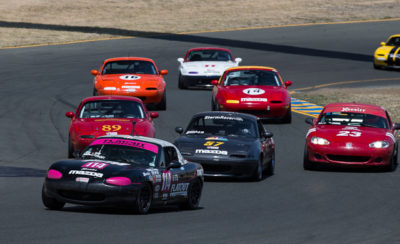Choosing a new shock for Spec Miata was the result of an exhaustive, comprehensive process
Choosing a new shock that will eventually be mandated for hundreds of Spec Miata competitors was no small job, and the process that Mazda Motorsports and its partners used to eventually choose Penske shocks as the new supplier was extensive. At the heart of the process was a four-day, dry and wet test at Carolina Motorsports Park with Joel Miller, Randy Pobst and John Dean II handling the driving duties. During those four days, 72 different combinations of driver, damper and tires were tested at CMP – but the process began long before that.
“We put it out to RFP [Request For Proposal], then invited seven manufacturers to the test,” explains David Cook, manager of business development for Mazda Motorsports. “Even before the test, based on the RFP, we sent manufacturers current shocks to dig into. Some of the manufacturers rented cars and put the shocks they were going to bring to the test on a shaker rig. All of the manufacturers came very well prepared.
“We brought Toyo, Hoosier, NASA and SCCA, along with Long Road Racing and Panic Motorsports, to see if we could come up with a better overall value for the class,” Cook continues. “We allowed each manufacturer to start with two sets of shocks, although not all of them took advantage of that. Some brought a set of adjustable shocks rather than separate shocks with different valving. Then we allowed re-valves after feedback.”
Long Road Racing conducted the test, with Panic Motorsports supplying three cars – a 1.6L NA, a ’99 NB and 2001 with the VVT engine – and handling the mechanical support side of the equation. Both Hoosier and Toyo tires were used, because Hoosier is the official tire of the class for SCCA and Toyo is the official tire for NASA. In addition, some testing was done with the Hoosier SM8, a proposed update to the spec tire for SCCA.
“It was terrific – and of course I loved it because I drove hours and hours every day,” says Pobst. “Every time we finished a run, while still sitting in the car sweating, each driver would do a rating. We did a ranking and comments immediately after stopping.”
Pobst’s fellow tester, Miller, who has driven a huge variety of race cars and also serves as the driver coach for the Mazda Road to Indy, prepared an exhaustive report on the process and how the test was conducted. It provides a good look into how a test to reach such an important conclusion is done.
“The test consisted of four on-track days where manufacturers were able to make changes based on driver feedback to offer the best possible product for the class,” says Miller. “Evaluation metrics included braking, acceleration, control of motion, ease of use from a pro/semi-pro/amateur drivability, tire degradation, cost to the customer, and overall value to the Spec Miata brand. On-track sessions consisted of short qualifying simulations, long race runs, and both wet plus dry weather running. Various tire combinations were tested once the final two manufactures were selected to ensure the damper could run on the new for 2019 tire spec.”
Miller reports that the first two days were done in dry track conditions. The first day consisted of only short runs – 20-minute sessions – in order to get each shock tested. Then any shocks that were adjusted overnight had another short run before long runs began. These runs were an hour long and designed to evaluate tire and lap time degradation. Hoosier SM7 tires, the current SCCA spec, were used for all initial tests.
“The goal was to evaluate each damper over a short 20 minute run then followed up by a one-hour run before any elimination was considered. Evaluations consisted of comparing compression under braking, rebound under acceleration, transitional motion, overall control of motion, ease for a pro driver/semi experienced/amateur, tire degradation over a run, and overall feel,” explains Miller.
After two days, the field was narrowed to three manufacturers. In the next part we’ll explore how the remaining shocks were evaluated and a conclusion reached.


 ACCESSIBILITY
ACCESSIBILITY